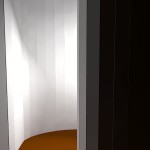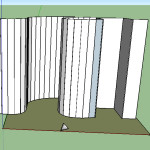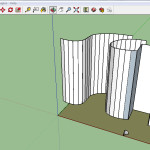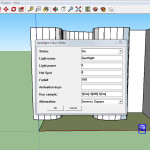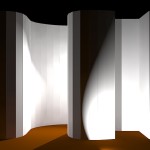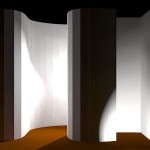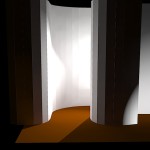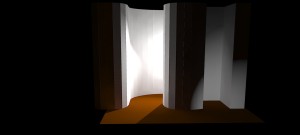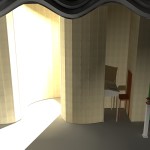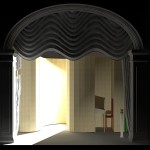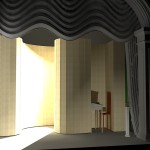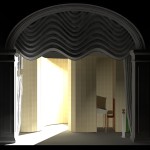
Introduction
Today I met with my colleges Siyao and Steven in an to attempt to apply some of our previous research on, and prior learning about, the use of software-based rendering engines and lighting plug-ins with SketchUp Make. We hoped to review our research about Edward Gordon Craig’s and W.B. Yeats’s stage designs for the Abbey theatre in Dublin, in an endeavour to apply lighting to our colleague Laura’s finished three dimensional (3D) model for The Hour-Glass.
For this purpose, and as a direct result of Siyao’s technical research on and evaluation of suitable software, we settled on using the free Kerkythea rendering engine and corresponding plug-in for SketchUp Make.
In-keeping with the overall project aims, we hoped to create some rendered images of Craig’s scenic designs for The Hour-Glass (Yeats Irish Theatre), with applied lighting settings, to visualise how the screens may have appeared when they were in use at the Abbey theatre. The resulting rendered images will then be published by Siyao on this project blog site (these images can be viewed by clicking here).
In further acknowledgement of the principles set-out in the London Charter for digital cultural heritage visualisation (Denard, London Charter), we decided to publish an account of our experiences in an attempt to make our methodological process as transparent as possible. For a more detailed discussion of how the London Charter applies to our visualisation project, please see Gráinne’s blog post. All of the images included below are hyper-linked, please click on any image to open an enlarged version.
The evidence: Choosing appropriate colours for lighting our scene from The Hour-Glass
Initially we decided to create our rendered images, with applied lighting, using the ‘full’ Hour-Glass 3D model—which includes Laura’s 3D model of Craig’s screens in situ within a 3D model of the old Abbey theatre stage, that was designed by Noho (Denard, Old Abbey). Our rationale for doing so was such that; we wished to allow potential visitors to the project blog site the opportunity to meaningfully contextualise how Edward Gordon Craig’s screens may have been lit, as they appeared on the Abbey theatre stage.
Reviewing the discussion that emerges from our research on Craig’s use of lighting, it seems that Craig preferred to light scenes as minimally as possible–by removing all unnecessary lighting from the scene. Writing on Craig’s interest in depicting contrast between light and dark–through his frequent and purposeful inclusion of steps, stairs and right-angled shapes to create shadows within his scenic designs, Jenifer Buckley (European Avant-gardes) notes how Craig’s:
‘drawings for [a production of a play entitled] The Steps are primarily concerned with the ways in which light can be used as a plastic element to shape the viewer’s response to geometrical forms’ (53).
Buckley goes on to discuss how Craig’s vision for a new kind of theatre offered a marked departure from the traditions of ‘realistic theatre’ by allowing ‘tender liquid light to feel its way across’ (62) a minimised stage setting. These intentions seem to be somewhat reflected in a woodcut engraving by Craig, which depicts his scenic designs for Yeats’s poetic drama The Hour-Glass. An image of Craig’s woodcutting appears in a book by Liam Miller (Noble Theatre 161), within which Craig’s use of strong bold lines appears to emphasise, not only a contrast between light and dark, but also captures Yeats’s intended divergence between the two central characters in his play; the Fool and the Wise Man.
There is some evidence to suggest that a colour-scheme of purple and red-brown with olive-green curtains (see Gráinne Kelly’s post entitled The Hour-Glass & Evidence for our Visualisation) was used in the Abbey theatre production of The Hour-Glass. However, it is also reasonable to assume that this colour-scheme may have applied only to the costumes for the characters, and not to the colour of the screens (which Gráinne Kelly notes as being ivory in colour) or even to the stage lights. As James Flannery (Visual Arts 87) notes:
‘Yeat’s first experiment with this new style of decor [that is, one which Yeats adopted as a result of Craig’s influence] was made with The Hour-Glass, when it was first produced at the Molesworth Hall on 14 March 1903. Staged with the costumes designed by Robert Gregory according to an overall design created by T.Sturge Moore, the colour scheme was striking and effective. The action, as Yeats describes it, took place in front of an olive-green curtain, with the Wise Man and his Pupils dressed in various shades of purple. A third colour, subordinate to the other two, was added by dressing the Fool in a red-brown costume with touches of green to harmonize with the curtain’
Flannery’s comments take on a further significance when we consider how strongly opposed, its seems, that Craig may have been to over-use of colour. Craig himself writes that the realistic stage is:
‘over-charged with spectacular material, with the massiveness of properties, with the carnevalesque confusion and riot of colours, thus becoming a chaos, which abolished all the laws of theatrical optics, the most elemental rules of Aesthetics’ (Living Theatre 37).
Similarly, Craig also writes that a competent stage-director must come know how to select ‘certain colours which seem to him to be in harmony with the spirit of the play, rejecting other colours as out of tune’ (Art of Theatre 157). Here Craig insists that colour should be used sparingly, and only to represent the primary elements of the scene that embody the ‘spirit’ of play.
A further example of this line of thinking is evident where Craig asserts that the complex works for the stage by William Shakespeare might be represented in just two simple colours; ‘one for the rock, the man; one for the mist, the spirit’ (23). Craig adds that in designing costumes and scenes one must ‘forget not that each colour contains many variations’ (ibid.). As such, Craig notes that ‘tone and colour’ can be brought ‘downwards until it reaches nearly to the level of the floor [with care taken] to bring this colour and this tone down in some place which is removed from the material rock-like substance’ (25). Morever, as Karen Dorn notes in her account of the professional collaboration between Yeats and Craig (Dialogue Into Movement), Yeats himself also indicated that it is the Fools wig that should be ‘red and matted’ (129).
Consequently, we have made [what we believe to be] the reasonable assumption that the lighting for the Hour-Glass was white in colour, and that the purple and red-brown colour-scheme was applied to the costumes–thus conscientiously avoiding any potential ‘riot of colour’ (Craig, Living Threatre 37). Moreover, the same rationale seems to have informed the application of stage lighting to the rendered images produced as part of an interesting 3D visualisation, built using the diagrams that appear in the original patent document which Craig obtained for his ‘screens’ concept, by Christopher Baugh et al. (Patent No 1771).
Determining the position of the lights for our scene
Having decided on the colour of the lights, we felt that the image of Craig’s woodcarving was deemed to be a crucial source of visual information regarding the position of the lights within our 3D model for The Hour-Glass. However, an initial observation was that Craig’s woodcarving seems to constitute a horizontally flipped representation of the Yeats sketch, upon which our 3D model is built. Images of the sketch, from Yeats’s notebooks, and Craig’s woodcut appear in both Liam Miller’s book (Noble Theatre 167) and in a book by Richard Allen Cave (Selected Plays 284). Along-side the Yeats sketch, a further image appears in Cave’s book showing a pencil drawing, also by Craig, of his scenic designs for The Hour-Glass (ibid.). In each of these images, and in our 3D model, the character of the Wise Man is seated to the right of the stage [when looking at the stage from the direction of the audience], and the character of the Fool appears to the left; in a flood of light [from the back of the stage] that illuminates a curved passageway created by the screens. In Craig’s woodcut the opposite is true, where the Fool appears on the right and the Wise Man to the left. Notwithstanding that the image of the woodcut may have inadvertently, or necessarily, been printed in flipped fashion [by virtue of the medium in which the original carving was created, and that in which it is subsequently printed]–we felt that, as the greater volume of evidence suggests, the former configuration is more likely to have been the one that was implemented at the Abbey theatre. In an attempt to thereby align our lighting configurations, as-much-as-possible, with Craig’s intended designs we used Adobe PhotoShop to create an appropriately horizontally-flipped version of the printed image of Craig’s woodcut. This also helped us to better understand the direction, and position, of the stage lights.
Informed by the [horizontally flipped] image of Craig’s woodcut, using the Kerkythea plug-in for SketchUp Make, we decided to back-light the entire left-side of the backstage area with a ‘point-light’ and we also considered using a spot-light to illuminate the Wise Man in the foreground.
Lighting the rear-stage area
We positioned our point-lights for the backstage area, exported the model for use within the Kerkythea rendering engine environment, and opened the model in Kerkythea. However, due to the complexity of the full 3D model [which includes the entire Abbey theatre stage], it proved difficult to quickly maneuver around our model within the Kerkythea rendering engine environment and the application seemed quite sluggish and unresponsive at times. We opted instead to use a striped-down basic 3D model–which consists only of the stage floor and screens, without the surrounding Abbey theatre stage architecture. This allowed us to determine suitable lighting settings and positions within the basic model, and to consider applying these lighting settings to the more complex model, for rendering, at a later stage.
We spent 1.5 hours positioning the back-light and changing the intensity of the light to match Craig’s woodcut image. We thought it better to use a single spot-light instead of a point-light, which we felt would give a similar lighting profile to a lamp. We figured that a lamp would perhaps best represent the extent of the technology that would have been available to Yeats in the Abbey theatre in 1911, when The Hour-Glass was staged there.
- This is 01/04 images from Siyao, showing our adjustments to the intensity level of the back stage spot-light in Kerkythea
- 02/04 back stage spot-light intensity level adjustment
- 03/04 back stage spot-light intensity level adjustment
- 04/04 back stage spot-light intensity level adjustment
Illuminating the Wise Man
We then spent close to 0.5 hours debating the possible position of a second light that is used to illuminate the figure of the Wise Man, who is depicted as sitting at his desk towards the centre of the stage in Craig’s woodcut. We wanted to capture Craig’s intended contrast between light and dark, and to use the lighting to fulfil Yeats’s intentions to posit the character of the Wise Man as being distinctly different–if not almost a binary opposite–to that of the character of the Fool [as previously discussed]. We also wanted to capture the way in which the light seems to spread out; casting shadow across the stage in Craig’s woodcut image.
To achieve the form of the shadow that appears in the woodcut image, the most likely position for the second light source [illuminating the Wise Man] seems to have been a foot-light. As it typical of where they are positioned; this foot-light would need to be placed near the front-centre of the stage, low down at floor level, and directed at an extremely low angle across the seated figure of the Wise Man–thus casting his shadow on the rear alcove area that is created by the configuration of screens. The use of footlights may, at first, seem to contradict common understanding of Craig’s vision for a new theatre. However, some support for our decision may exist where–on the subject of being misquoted about his intentions for the use of foot-lighting (Art of the Theatre x)–interestingly, Craig writes:
‘[w]hat I had said was [remove] “some footlights”: what I had done was to remove all the footlights . . . and then put some back again. It is quite likely I should put back all the footlights were I at work in my own theatre and remove certain other lights.’
We also considered the idea that a lamp may have been positioned behind one of the curved screens, so that it would shine through the, silk textured, flat screen directly in front of the Wise Man’s desk. As tantalisingly innovative an application of Craig’s screens and novel use of lighting this may have been, unfortunately it conflicts with the direction of the shadow that the Wise Man is depicted as casting on the wall to his right [at the back of the stage].
- This is 01/02 images from Siyao, showing our adjustments to the position and direction of the front of stage spot-light in SketchUp Make for rendering in Kerkythea
- 02/02 adjustment to front of stage spot-light
Setting the appropriate level of light intensity for our scene
While there were some issues with finding the correct positions for the spotlights, and then pointing them in appropriate directions, our next challenge was to set the power/ intensity levels of the lights so that they matched the luminescence of the light as it appears in Craig’s woodcut. This was a slow process that involved checking our light settings by producing rendered images in Kerkythea, and then continuously manually adjusting, reviewing and re-adjusting–with lots of switching, importing and exporting between Kerkythea and SketchUp Make–until we felt that we had got it right.
- This is 01/02 images from Siyao, showing our adjustments to the power setting for the front of stage spot-light in SketchUp Make for rendering in Kerkythea
- 02/02 front of stage spot-light power setting adjustments
In the course of doing so, we noticed that there was an issue with coronas from the spotlights appearing in our rendered image captures. These coronas appear as halo-like dots of intense light. We managed to correct this problem by changing the attenuation settings of each of the spotlights, in SketchUp Make, from ‘inverse square’ to ‘none’. However, this also meant that we had to subsequently reduce the luminescence of each spotlight accordingly in order to compensate for the absence of attenuation of the light sources–which had made the lights appear too bright, and washed out the scene with too much white light.
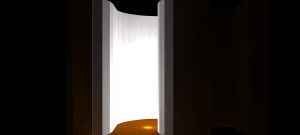
This is an image from Siyao that shows an intense spot of bright light on the floor of the stage in the curved passage way
It took us close to four hours to get the light settings correct.
- This is 01/05 images from Siyao showing the results of our adjustments to the direction and power level of the front of stage spot-light as rendered in Kerkythea
- Front spot-light direction & power adjustment 02/05
- Front spot-light direction & power adjustment 03/05
- Front spot-light direction & power adjustment 04/05
- Front spot-light direction & power adjustment 05/05
Migrating our lighting designs to the full model of the Abbey theatre stage
After some discussion with the other project participants the next day, we decided that we should attempt to add our lighting designs for the basic screen model to the full model [with the screens in situ inside the model of the Abbey theatre stage] for The Hour-Glass. As a group, we felt that doing so would allow visitors to the blog site to gain a more realistic visual impression of how Craig’s screens would have appeared on stage at the Abbey theatre.
In doing so, it was necessary to use Kerkythea to apply the same configurations for lighting (positions, directions, intensity and attenuation settings) to the full model for The Hour-Glass. Interestingly, our second attempt took only ten minutes to complete–in comparison to the four hours we spent doing the same thing the previous day. Siyao, Steven and I then spent a further ten minutes tweaking our settings by adjusting and reviewing the rendered image captures [as before], until we felt that they matched Craig’s woodcutting–as closely as possible.
We saved the SketchUp Make model [in .SKB file format], the Kerkythea scene [in .KRV file format], and the Kerkythea light settings [in .XML file format]. Siyao took a copy of these files, which she will use to create some finalised rendered images of the model for her own blog post.
Conclusions
This was our first attempt at applying lighting to a 3D model. Given that, on the second day, it took us a total of twenty minutes to do what we had done in four hours on the first day–it seems evident that there has been some substantial progression in respect of our relative competence in using Kerkythea for lighting. We now have a 3D model of Craig’s screen designs for Yeats’s play The Hour-Glass, set in the Abbey theatre stage, to which we have successfully applied light settings–that, we believe, accurately match the available evidence. The process of applying lighting to our 3D model forced us to confront a number of key questions that otherwise may not have been raised–such as those related to the colour and likely position of the lights. Emerging from this, and in the spirit of The London Charter, is a well-learned practical lesson that truly emphasises the importance of publishing details about the various decisions and choices made in the course of creating a visualisation like this one. Each of us feel confident that we can apply our learning to future projects, and I sincerely hope that sharing our journey will prove useful to anyone wishing to undertake a project of a similar nature.
- This is 1/4 images showing Craig’s screen designs for the play The Hour-Glass by W.B. Yeats, with lighting applied using Kerkythea. For these images I took a similar approach to Clare [see: https://craigscreens.blog.oldabbeytheatre.net/?p=561] and added props that I downloaded from SketchUp Warehouse.
- This is 2/4 images of screen The Hour-Glass with lighting and props.
- This is 3/4 images of screen The Hour-Glass with lighting and props.
- This is 4/4 images of screen The Hour-Glass with lighting and props.
Cited work
Adobe Systems Incorporated. Adobe Photoshop. Ver. CS5 Extended v12.0 x 32. Computer software, 2010. PC. Disc.
Baugh, Christopher, Gavin Carver and Cat Fergusson. “Patent No 1771: Gordon Craig and ‘Improvements in Stage Scenery’, 1910.” Scenography International 1.1 (1999): n.pag. Web. 10 Nov. 2013.
Buckley, Jennifer. Print, Performance, and the European Avant gardes, 1905-1948. New York: Columbia University, 2011. Web. 24 Feb. 2013.
Cave, Richard Allen. Ed. W.B. Yeats: Selected Plays. London: Penguin Group, 1997. Print.
Craig, Edward. On the Art of the Theatre. 5th ed. London: William Heinemann Ltd., 1957. Web. 25 Feb. 2014.
Craig, Edward and The School for Art and Theatre. A Living Theatre: The Gordon Craig School, the Arena Goldoni, the Mask; Setting Forth the Aims and Objects of the Movement and Showing by Many Illustrations, the City of Florence [and] the Arena. Florence: The School for Art and Theatre, 1913. Web. 26 Feb. 2014.
Denard, Hugh. Abbey Theatre, 1904: Digitally Reconstructing Dublin’s Original Abbey Theatre. Trinity College Dublin Long Room Hub and NOHO, 2011. Web. 13 March 2014.
Denard, Hugh. The London Charter: For the Computer-based Visualisation of Cultural Heritage. N.p.: n.p., 2009. Web. 11 Oct 2013.
Dorn, Karen. “Dialogue Into Movement: W.B. Yeats’s Theatre Collaboration With Gordon Craig.” Yeats and the Theatre. Eds. Robert O’Driscoll and Lorna Reynolds. London: The MacMillan Press Limited, 1975. 109-136. Print.
Flannery, James. “W.B. Yeats, Gordon Craig and the Visual Arts of the Theatre.” Yeats and the Theatre. Eds. Robert O’Driscoll and Lorna Reynolds. London: The MacMillan Press Limited, 1975. 82-108. Print.
Miller, Liam. The Noble Theatre of W.B. Yeats. Dublin: The Dolmen Press, 1977. Print.
Solid Iris Technologies. Kerkythea rendering engine. Ver. 2.0.19. Computer software. Solid Iris Technologies, n.d. PC, 3.0MB, Web. 04 Apr. 2014.
Solid Iris Technologies. Kerkythea SketchUp Plugin. Ver. 3.17. Computer software. Solid Iris Technologies, n.d. PC, 52.7KB, Web. 04 Apr. 2014.
Trimble Navigation Limited. SketchUp Make. Ver. 2014. Computer software. Trimble Navigation Limited, 2014. PC, Web. 04 Apr. 2014.
Yeats, William. Plays for an Irish Theatre: With Designs by Gordon Craig. 2nd ed. London: A.H. Bullen, 1913. Web. 25 Feb. 2014.

